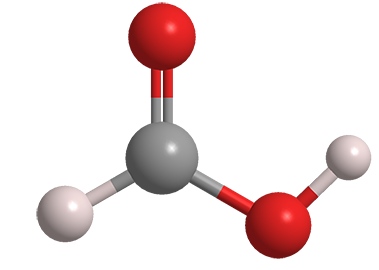Math Is Fun Forum
You are not logged in.
- Topics: Active | Unanswered
Pages: 1
#1 2025-04-21 17:51:32
- Jai Ganesh
- Administrator

- Registered: 2005-06-28
- Posts: 50,571
Formic Acid
Formic Acid
Gist
Methanoic acid, also known as formic acid, is the simplest carboxylic acid with the chemical formula HCOOH. It's a colorless liquid with a pungent odor and a sour taste. Formic acid is naturally found in some ant stings and is used as a preservative and antibacterial agent.
Summary
Formic acid (HCO2H), the simplest of the carboxylic acids, used in processing textiles and leather. Formic acid was first isolated from certain ants and was named after the Latin formica, meaning “ant.” It is made by the action of sulfuric acid upon sodium formate, which is produced from carbon monoxide and sodium hydroxide.
Formic acid is also prepared in the form of its esters by treatment of carbon monoxide with an alcohol such as methanol (methyl alcohol) in the presence of a catalyst.
Formic acid is not a typical carboxylic acid; it is distinguished by its acid strength, its failure to form an anhydride, and its reactivity as a reducing agent—a property due to the ―CHO group, which imparts some of the character of an aldehyde. The methyl and ethyl esters of formic acid are commercially produced. Concentrated sulfuric acid dehydrates formic acid to carbon monoxide.
Pure formic acid is a colourless, fuming liquid with a pungent odour; it irritates the mucous membranes and blisters the skin. It freezes at 8.4 °C (47.1 °F) and boils at 100.7 °C (213.3 °F).
Details
Formic acid (from Latin formica 'ant'), systematically named methanoic acid, is the simplest carboxylic acid. It has the chemical formula HCOOH and structure H−C(=O)−O−H. This acid is an important intermediate in chemical synthesis and occurs naturally, most notably in some ants. Esters, salts, and the anion derived from formic acid are called formates. Industrially, formic acid is produced from methanol.
Natural occurrence
Formic acid is found naturally in insects, weeds, fruits and vegetables, and forest emissions. It appears in most ants and in stingless bees of the genus Oxytrigona. Wood ants from the genus Formica can spray formic acid on their prey or to defend the nest. The puss moth caterpillar (Cerura vinula) will spray it as well when threatened by predators. It is also found in the trichomes of stinging nettle (Urtica dioica). Apart from that, this acid is incorporated in many fruits such as pineapple (0.21 mg per 100 g), apple (2 mg per 100 g) and kiwi (1 mg per 100 g), as well as in many vegetables, namely onion (45 mg per 100 g), eggplant (1.34 mg per 100 g) and, in extremely low concentrations, cucumber (0.11 mg per 100 g). Formic acid is a naturally occurring component of the atmosphere primarily due to forest emissions.
History
As early as the 15th century, some alchemists and naturalists were aware that ant hills give off an acidic vapor. The first person to describe the isolation of this substance (by the distillation of large numbers of ants) was the English naturalist John Ray, in 1671. Ants secrete the formic acid for attack and defense purposes. Formic acid was first synthesized from hydrocyanic acid by the French chemist Joseph Gay-Lussac. In 1855, another French chemist, Marcellin Berthelot, developed a synthesis from carbon monoxide similar to the process used today.
Formic acid was long considered a chemical compound of only minor interest in the chemical industry. In the late 1960s, significant quantities became available as a byproduct of acetic acid production. It now finds increasing use as a preservative and antibacterial in livestock feed.
Properties
Formic acid is a colorless liquid having a pungent, penetrating odor at room temperature, comparable to the related acetic acid. Formic acid is about ten times stronger than acetic acid having a (logarithmic) dissociation constant of 3.745 compared to 4.756 for acetic acid.
It is miscible with water and most polar organic solvents, and is somewhat soluble in hydrocarbons. In hydrocarbons and in the vapor phase, it consists of hydrogen-bonded dimers rather than individual molecules. Owing to its tendency to hydrogen-bond, gaseous formic acid does not obey the ideal gas law. Solid formic acid, which can exist in either of two polymorphs, consists of an effectively endless network of hydrogen-bonded formic acid molecules. Formic acid forms a high-boiling azeotrope with water (107.3 °C; 77.5% formic acid). Liquid formic acid tends to supercool.

It appears to me that if one wants to make progress in mathematics, one should study the masters and not the pupils. - Niels Henrik Abel.
Nothing is better than reading and gaining more and more knowledge - Stephen William Hawking.
Offline
Pages: 1